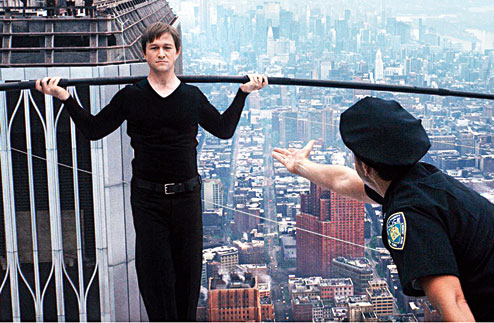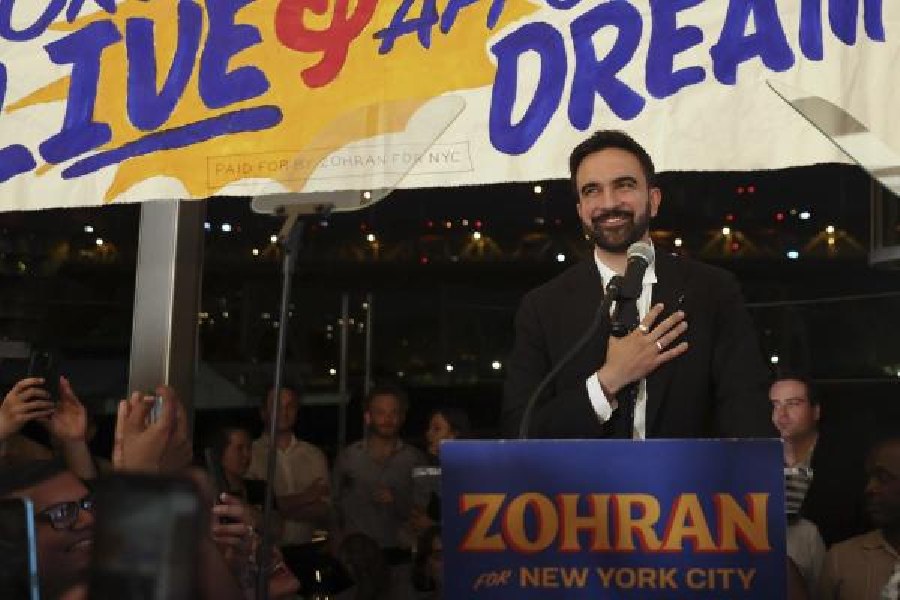
Joseph Gordon-Levitt slips into the shoes of wire walker Philippe Petit — the only man to walk between the twin towers of the World Trade Center in New York — for Friday film The Walk, directed by Robert Zemeckis.
How did you prepare for this role?
It was a very challenging role. I love a challenge, and I love to work hard. There were two parts (of preparation). The first was the physical part of learning how to walk a wire. I actually studied with Philippe Petit. He was the one who taught me how... he put together an elaborate workshop. He also taught me about music, the philosophy of art, magic, and tying knots.... He said that by the end of eight days, I’d be able to walk on my own. This goal sounded a bit ambitious to me, but he’s such a positive thinker — he’s so optimistic, it’s inspiring.
How did you conceive of the emotions involved in walking between the towers?
No one has ever crossed the towers except for Philippe. I couldn’t claim to know exactly how it felt, but I guess you just have to use your imagination. You know, I think we all have those moments where there’s something we would love to do and accomplish — it’s risky and it seems impossible, and a part of ourselves just doesn’t want to try, but it’s rewarding if you do try, and you don’t let the impossible-ness of it discourage you. That’s something I think we can all identify with.
What does it mean to risk it as an actor?
Well, it’s similar to a wire walker, you know? When you’re on the wire —Philippe talked to me about this — you can’t spend your time thinking, ‘What if I fall?’ As soon as your mind goes there, it will happen. It’s the same with acting. You can’t think: ‘What if this doesn’t go well?’ ‘What if forget my lines?’ ‘What if I mess it up?’ ‘What if people don’t like it?’ It’s just distracting and useless — you just have to focus on your performance and embodying your character.
What do you think about while walking on the wire?
On the wire you just look straight ahead and you focus on the end. You don’t take your eyes off it. You don’t look anywhere else, and you don’t think of anything else. You just fix your eyes on that and be present in exactly what you’re doing — moving your feet carefully, and balancing your body.

Can you relate to Petit’s mission to accomplish the impossible?
Sure. That makes me think of this project I have called Hit Records. It started as a very small project many years ago, and it’s grown and grown. We make all kinds of things — short films, books, or music... we do a TV show, and air it on the Net. We do it differently — and anyone can come join our community and contribute to these collaborative projects that we do. It’s something I’ve done for a long time and is very personal to me —- I love these very much. Five years ago, we tried to launch as a professional production company, and were thinking about our goals. Our loftiest goal was to make a TV show wherein people from all over the world contribute via the Internet and collaborate to make this TV show. It seemed impossible at the time as even making a short film is really hard. We worked very hard up to it, and we finally made the show (HitRecord on TV), and we even won an Emmy!
Was it always you on the wire or always the stunt double?
There was both I and the stunt double. The stunt double is this really wonderful wire walker named Jade Martin. We both walked on the wire.
Did you feel scared walking on the wire?
Did I feel scared?! Of course! I was scared because it’s quite unnatural to walk on a wire — if you think about it. Even at a low height it feels so high. Your body just tenses up with fear... it’s your instinct. Certainly I wasn’t as high as Philippe ever was. Even though I knew I would be okay because I had a safety harness on — and just to clarify for my own pride, the safety harness does not help you balance. If anything, when they pull on the harness you’re thrown off balance. It’s just there in case you fall. I didn’t fall, but the funny thing is just knowing that I had the safety harness on doesn’t help — your mind doesn’t register the fact. It’s scary on a basic animal level. All you can think about is that you shouldn’t be up so high. The only thing that fixes it is time. Over time you get acclimatised, and I got less scared.
Philippe brings a degree of antagonism to the theory of art. Would you say this is a quality of an artiste?
Yes. That’s interesting. I had a really interesting conversation with him about the context of the walk in 1974 when he did it. This was a turbulent time in American history — the Civil Rights Movement, the Feminist Movement, and the Anti-War movement was at its peak. Everyone was fed up with Vietnam. There was a huge scandal — the President (Richard Nixon) had actually resigned within days of the walk. I asked Philippe if he thought the walk was a symbol within that social context — proving that what we all thought was impossible was in fact possible, and that people could open their minds to new ideas and change. He said not at all, and that this hadn’t crossed their minds at all. He said that he didn’t think was his place. He said: ‘For me, there are people who know much more about that than I do. I know that I had this idea that it was pure beauty to me, and I had to do it. How anybody chooses to interpret this is up to them’. I thought this was a very humble interpretation of his own art.
Would you say Philippe was a mad person or a dreamer?
He himself would admit he was mad when he was 24! Keep in mind I met him 40 years later and he’s changed and grown a lot since then. But yeah, this is part of what I loved about this movie. Often times when you make a grand spectacular action movie, the characters are often boring and simplistic because the point of the film is just the visuals without much of a human story behind it. But with this film, I got to do these grand spectacular action sequences and also have a character that I could really sink my teeth into. The performances that Mr Zemeckis and I spoke about were George C. Scott in Patton, or the movie Amadeus. These movies are about individuals who are brilliant in their own right, and also out of their minds. That makes for a fantastic character.

What was your first response to the script?
Mr Zemeckis just asked to have a meeting with me. It was incredibly exciting because I have always loved his movies since I was a kid. He’s actually been talking about this movie even before the documentary (Man on Wire, 2008) came out. He was first inspired by a children’s book, that I recommend, called The Man Who Walked Between The Two Towers. It’s filled with beautiful hand-painted illustrations. He told me he was looking for a story to tell wherein 3D visuals were absolutely necessary. Often 3D visual effects are tacked on at the end, and he wanted a story where 3D visuals were baked into the story. When someone gave this book to his son, and he saw the cover — where in the foreground you see Philippe’s foot on the wire and in the background you see all of New York City — he said that this was when he found his movie.
He did extensive interviews with Philippe, recording the interviews, and even spent time with Philippe on the wire. There is actually no footage of the walk. There are only a few photographs that Philippe’s friend took. (In the film, his friend tries to film Philippe’s walk, but that’s when the cops come. The film stays very true to fact.) So Philippe re-enacted all of it for Bob (Zemeckis) who told me all about it. To be honest, I don’t think this film would have worked in the hands of a lesser filmmaker than Mr Zemeckis... he is such a master of visuals and character. I knew this was going to be a special film, and I was just delighted and honoured.
How did you learn to speak like Philippe?
I learned so much from Philippe. First of all, listening to him speak was so important. I wanted to speak like him, but I didn’t want to do an impersonation.
What do you think of the finished film?
I loved it! Even when I first saw a rough cut without any special effects, I fell right into it, like an audience member, which I don’t always do for rough cuts. This is a tribute to what an excellent storyteller Mr Zemeckis is.










